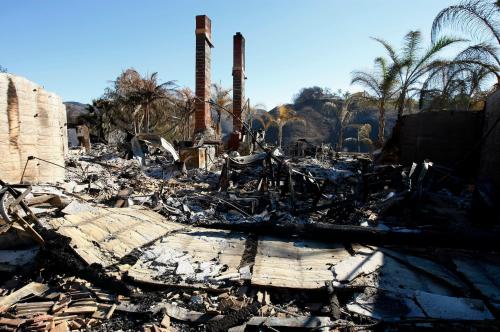Back in June, Henry Paulson, the former U.S. Secretary of the Treasury, published an opinion piece in the New York Times calling for a price on carbon dioxide emissions. Mr. Paulson correctly asserts that “putting a price on emissions will create incentives to develop new, cleaner energy technologies.” It will also create incentives to make coal-fired power plants more efficient, reducing the amount of carbon dioxide they emit. More importantly, as my recent Brookings working paper illustrates, it will encourage a switch of electricity production from inefficient coal-fired plants to more efficient natural gas-fired power plants, reducing CO2 emissions by as much as two-thirds per megawatt-hour.
In his article, Mr. Paulson used the words “putting a price on carbon dioxide emissions” and “carbon tax” interchangeably. In this he was incorrect. A carbon tax is one way to put a price on emissions. Cap-and-trade is another. A carbon tax and cap-and-trade are opposite sides of the same coin. A carbon tax sets the price of carbon dioxide emissions and allows the market to determine the quantity of emission reductions. Cap-and-trade sets the quantity of emissions reductions and lets the market determine the price. Which of the two is better?
Which Has Greater Uncertainty and Imposes More Risks?
Under either a carbon tax or a cap-and-trade program, the desired result is a level of CO2 abatement which equates the cost of abatement with the estimated benefits of abatement. However, with cap-and-trade, the market price of CO2 allowances may be less or more than the estimated benefits per ton of CO2 abatement. On the other hand, the amount of abatement generated by a carbon tax may be less or more than the amount required to equate the cost of abatement with the benefit of abatement. Thus both entail risks.
Both cap-and-trade and a carbon tax are subject to uncertainty about benefits. However, cap-and-trade has the advantage of reducing some of the uncertainty about benefits. We know that the benefit of carbon abatement is a function of the rise in global temperature which in turn is a function of the quantity of CO2 emissions. Cap-and-trade sets the allowable quantity of emissions, which can then be used to estimate the decline in the rise of global temperature and the resulting benefits. We do not know in advance the effect that any particular carbon tax level will have on emissions and therefore on estimated benefits.
Both cap-and-trade and a carbon tax are subject to uncertainty about costs. However, cap-and-trade has the advantage of making clear, through a market price for emissions, the actual cost of a stipulated quantity of emissions reductions. Furthermore, the market price for CO2 allowances under cap-and-trade automatically and continuously adjusts for changes in abatement cost over time as changes take place in the prices of fossil fuels, the demand for electricity, and the rate of technological change (The price for natural gas affects greatly the cost of abatement as demonstrated in my Brookings Working Paper.) Frequent changes in a carbon tax to adjust the tax level to the changing cost of abatement are likely to be administratively difficult and politically divisive.
Which Is Easier and Less Costly to Administer?
Clearly a carbon tax is easier to administer. Both cap-and-trade and a carbon tax need to be enforced – emissions must be determined for various sources and penalties imposed if a source does not have the requisite allowances or does not pay the required taxes.
However, with cap-and-trade there is an additional administrative requirement – the allocation of allowances. Early attempts at allocation of allowances – for example, the sulfur dioxide emissions trading system used by the United States in the 1990’s – allocated allowances on the basis of historical emissions by source. The more modern approach is to auction allowances as done by the nine eastern U.S. states comprising the Regional Greenhouse Gas Initiative (RGGI). Auctions are easier to administer and more palatable politically.
Cap-and-trade would be prohibitively expensive to administer if applied to automobile transportation or residential heating and cooling. Thus a tax on fuels used for transportation, heating, and cooling is the preferred way to promote CO2 emissions abatement in these sectors.
Which Is More Likely to be Politically Palatable?
Carbon taxes on fuels for transportation and heating and cooling of buildings in some instances have been popular, especially when designed to be tax neutral in that carbon tax revenues are used to reduce other taxes. The carbon tax in the Canadian province of British Columbia is a prime example. Nearly all of the province’s electricity is produced by hydro and biomass and there is little need to restrict emissions from large industrial plants.
However, carbon taxes on large electricity, steel, chemical and cement plants meet considerable resistance from vested interests – Australia is a prime example. In July this year, the Australian legislature, with the strong encouragement of current conservative Prime Minister Tony Abbott, repealed a carbon tax law introduced two years ago under the aegis of a more liberal previous government. The costs — a tax of A$24 per ton of emissions (a cost of about A$24 per megawatt-hour of coal-fired power production) and a total cost of A$9 billion — were all too apparent, immediate, and substantial. The benefits were not apparent or easily explainable to the body politic.
Cap-and-trade markets for utility-scale power plants are politically viable. They are operating in ten states in the U.S. and the European Union. More U.S. states may adopt cap-and-trade policies to achieve Environmental Protection Agency (EPA) proposed reductions in state-wide carbon dioxide emissions (see my blog on this subject). China is establishing seven regional pilot programs for emissions trading, all but one of which is already up and running.
What Mix of Policies Combines the Best of Cap-and-Trade and a Carbon Tax?
One of the potential disadvantages of cap-and-trade is that without limit on the price of allowances, the cost of abatement can far exceed the estimated benefits of abatement. However, this problem is easily solved – put an upper limit on the price of allowances. This is precisely what the RGGI has attempted to do by instituting a Cost Containment Reserve of emission allowances, which can be sold by the participating states to market participants at a fixed price in lieu of requiring them to buy allowances through the auctions. Provided the reserve is large enough, this puts a cap on the price of the allowances. In effect a source of emissions can either buy an allowance through the market or pay a tax.
Both cap-and-trade with a ceiling price and carbon taxes have useful roles to play, the former in restraining emissions from large industrial plants and the latter in cutting emissions in transportation, heating and cooling.
The Brookings Institution is committed to quality, independence, and impact.
We are supported by a diverse array of funders. In line with our values and policies, each Brookings publication represents the sole views of its author(s).



Commentary
Pricing Carbon: A Carbon Tax or Cap-And-Trade?
August 12, 2014